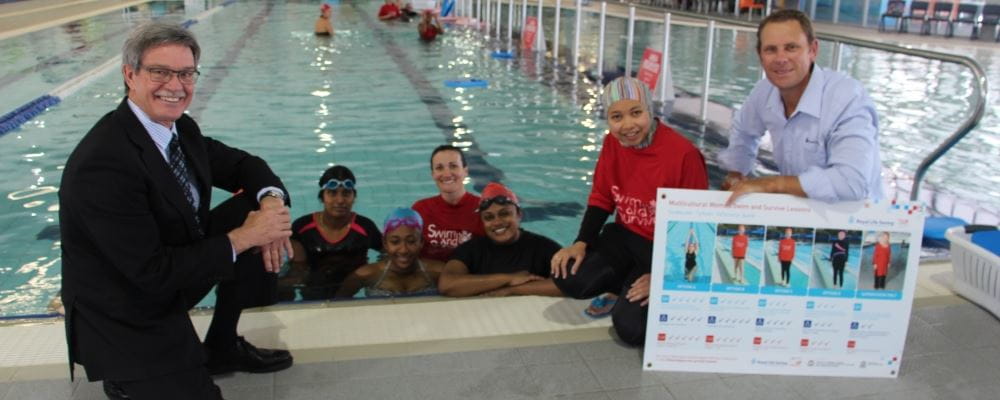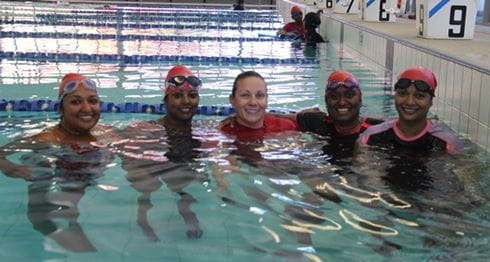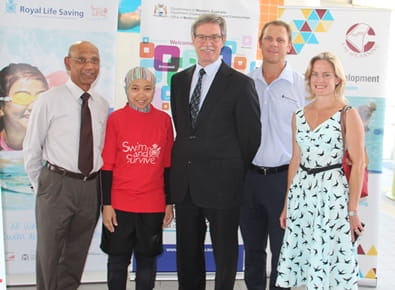
Minister for Multicultural Interests Mike Nahan, with Swim Instructor Titisari Titisari and Royal Life Saving Society CEO Peter Leaversuch beside the pool with women taking part in a women's only lesson at Cannington Leisureplex
Enabling at risk women to Swim and Survive
A review of drowning data over the past 5 years indicates there have been 50 drowning deaths in WA involving members of the Culturally and Linguistically Diverse (CaLD) Community, which represents 37% of all drowning deaths.
Limited water safety awareness combined with alarmingly low participation levels in swimming and water safety programs are contributing factors to this over-representation of CaLD community members in the WA Drowning Report.
Royal Life Saving Society WA CEO Peter Leaversuch says “Often swimming and water safety education is overlooked by new migrants due to barriers such as cost and availability, and for many migrant women the issue of cultural modesty is extremely important. We’re working hard to address these barriers to participation so that swimming, lifesaving and community education programs are appropriate and accessible to all Australians.”
Royal Life Saving Society WA is providing strong leadership and collaborating with government and non-government organisations to enact change, and this year we have placed a strong focus on fast tracking engagement with Vietnamese, Chinese, Indian and African communities.
A taskforce was established in order to gather the collective knowledge of local agencies including Chung Wah, the Indian Society, settlement agencies, ISHAR, Communicare and the Office of Multicultural Interests to better understand the barriers, cultural understandings and adaptations needed for successful change in these communities.
Royal Life Saving Society WA, in partnership with the Office of Multicultural Interests and the Department of Sport and Recreation has been conducting women’s only swimming lessons since 2009. We now have 3 programs running across the metropolitan area at Merriwa, Balga and Cannington.
Mr Leaversuch says the program aims to enable women to feel comfortable taking part. “We wanted to address the concerns many CaLD women had expressed about swimming in an environment where men were present, as this poses a cultural problem for them. The classes are led by female instructors where the women can feel at ease. In some cases classes are even held behind closed doors.”
The lessons run for an 8 week period during school terms, with crèche and pool entry included. This term there are 58 participants taking part at Cannington, 30 at Balga and 16 at Merriwa. Many of the women involved in these lessons have also been able to complete our Heart Beat Club program, which teaches basic first aid and CPR skills to assist them in caring for their children.

One former participant in the program, Titisari Titisari, has even continued on to become a qualified swimming instructor, teaching Infant Aquatics classes at Cannington Leisureplex. Ms Titisari says the Women's Only lessons made it easy to learn to swim. "The lessons were great because they not only taught me how to swim safely and the correct stroke but it also provided me with things I needed to make it possible, like creche for my children, and advice on the safest and most appropriate clothing for Muslim women like myself to wear in the pool."
Royal Life Saving Society WA has also recently completed the development of a Swim Wear Guide, advising CaLD women about the options available to them as we seek to address cultural requirements. The guide explains the suitability of the different swim wear options in a variety of swimming environments to ensure the women are aware of the risks associated with some of the more modest options.
Mr Leaversuch says “This program, and the swim wear options provided, work together to give women the opportunity to experience learning to swim as an enjoyable pastime. It enables them to take part in something that is an important part of Australian life.”
The Swimwear Guide will be shared with key stakeholders including:
- Lifeguards who will be able to effectively communicate with patrons why some swimwear options are only suitable for shallow water activities due to their weight and the restriction of movement.
- Swim instructors who will be able to help participants choose the right swimwear for their planned activities, as the wrong swimwear prohibits skill development.
- Participants who will be able to choose the options best for their activity, making physical activity enjoyable and fun.
The information in the guide will be communicated via a range of platforms including signage at centres, handouts at reception, cue cards for lifeguards, instructors and resources such as videos and personal stories to be shared online.